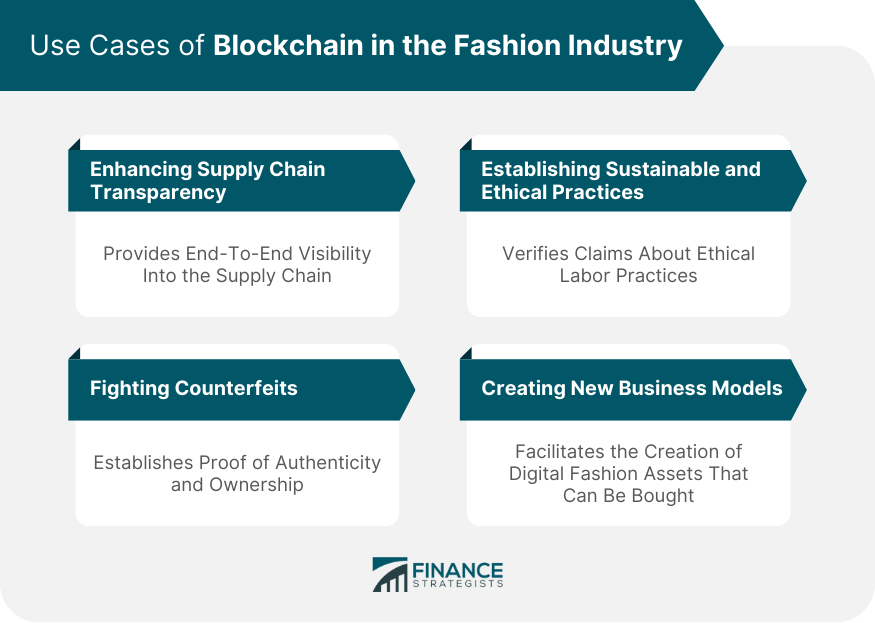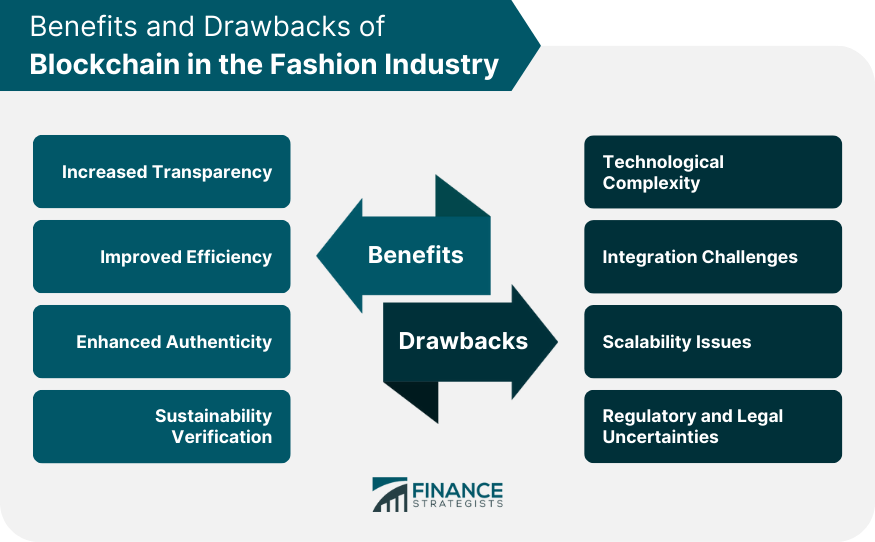Blockchain in the fashion industry refers to the application of distributed ledger technology in different aspects of the fashion ecosystem. Blockchain can be used to trace and track products, verify authenticity, improve supply chain transparency, fight counterfeits, and even create new business models such as digital fashion. The primary purpose of blockchain in fashion is to bring transparency, efficiency, and authenticity to the industry's various operations. Technology has become particularly important due to the fashion industry's vast and complex supply chains, its rampant counterfeiting problem, and the rising demand from consumers for sustainable and ethical practices. In the context of the fashion industry, the distributed ledger technology (DLT) that underpins blockchain provides a decentralized, transparent, and immutable record of data. This feature is instrumental in tracing a product's journey from raw materials to the final consumer, ensuring accountability at every stage. Smart contracts, which are self-executing contracts with terms and conditions written into code, play a crucial role in automating and streamlining various processes in the fashion industry. For instance, they can automate payments upon meeting certain conditions, ensuring efficiency and reducing the scope for disputes. Blockchain's ability to create a unique digital representation of physical assets, often referred to as tokenization, can be utilized to track and verify fashion products. Each product can be linked to a unique digital token on the blockchain, which carries its entire history and cannot be tampered with, ensuring authenticity. Blockchain can also establish proof of ownership, which is critical in the fight against counterfeits. By verifying the chain of ownership, consumers can be assured that the products they purchase are genuine, thus protecting brand reputations and consumer trust. Before implementing blockchain, fashion companies need to identify the specific problems they want the technology to solve. They must also assess the compatibility of blockchain with their existing systems, understand the legal and regulatory implications, and secure the necessary technical expertise for successful implementation. The implementation process typically involves choosing a suitable blockchain platform, designing the blockchain network architecture, developing the blockchain system, testing it, and then integrating it into the existing business operations. After implementation, continuous management and support are crucial to ensure the smooth functioning of the blockchain system. This includes monitoring the system, troubleshooting issues, updating the system as required, and training staff to work with the new technology. Blockchain can be used to provide end-to-end visibility into the supply chain. This allows all stakeholders, including consumers, to trace the origin of a product, verify its authenticity, and gain insight into the conditions under which it was manufactured. By establishing proof of authenticity and ownership, blockchain can be an effective tool against counterfeits. Consumers can check a product's digital token to ensure it is genuine, protecting both brand reputations and consumer interests. Blockchain can also prove the sustainability and ethical credentials of fashion brands. By tracking products from origin to end-user, it can verify claims about ethical labor practices, sustainable sourcing, and environmental impact, thereby increasing consumer trust in these brands. Blockchain opens up new possibilities for business models in the fashion industry. For instance, blockchain can facilitate the creation of digital fashion assets that can be bought, sold, and traded on blockchain platforms. Blockchain technology can provide unmatched transparency to the fashion industry by creating an immutable, decentralized, and transparent record of all transactions and interactions. This enhances traceability, accountability, and trust among all stakeholders, including consumers. Through the use of smart contracts and automation, blockchain can significantly increase efficiency in various processes within the fashion industry. This includes everything from production and inventory management to distribution and payments, resulting in time and cost savings. With blockchain's ability to track and verify products and establish proof of ownership, it can provide a robust defense against counterfeiting, a major problem in the fashion industry. This not only protects brand reputation but also increases consumer trust. As consumers become more conscious of sustainability, blockchain can help verify a brand's sustainable and ethical practices. This can provide a competitive edge to brands that prioritize sustainability, enhancing their reputation and appeal to consumers. Blockchain technology is complex, and its implementation requires significant technological expertise. This can pose a challenge for fashion companies, especially smaller ones without substantial IT resources. Integrating blockchain technology with existing systems can be a daunting task. It might necessitate significant changes to existing IT infrastructure, business processes, and workflows, potentially leading to disruption and additional costs. As blockchain networks grow and the volume of transactions increases, scalability can become an issue. It's essential to choose a blockchain platform that can handle the anticipated volume of transactions without compromising speed or performance. Given the nascent stage of blockchain technology, the regulatory environment is still evolving. This can lead to uncertainties and potential legal challenges for businesses using blockchain, especially those operating in multiple jurisdictions. Blockchain in the fashion industry provides unparalleled transparency, authenticity, and efficiency by offering a clear, tamper-proof record of all transactions and interactions. It counters rampant counterfeiting and substantiates sustainability and ethical practices, fulfilling modern consumer demands. While the potential benefits are compelling, it's crucial to note that blockchain implementation does not come without challenges. Its complex nature, integration issues, and the uncertainties associated with an evolving regulatory environment pose hurdles. Yet, with proper planning, technological expertise, and an understanding of the associated legal implications, these challenges can be surmountable. Embracing blockchain technology could thus revolutionize the fashion industry, making it more sustainable, ethical, and responsive to the needs of the modern consumer.What is Blockchain in the Fashion Industry?
How Blockchain in the Fashion Industry Works
Role of Distributed Ledger Technology
Utility of Smart Contracts
Tracking and Verifying Products
Establishing Proof of Ownership
Implementing Blockchain in the Fashion Industry
Pre-implementation Considerations
Steps to Successful Implementation
Post-implementation Management and Support
Use Cases of Blockchain in the Fashion Industry
Enhancing Supply Chain Transparency
Fighting Counterfeits
Establishing Sustainable and Ethical Practices
Creating New Business Models

Benefits of Blockchain in the Fashion Industry
Increased Transparency
Improved Efficiency
Enhanced Authenticity
Sustainability Verification
Drawbacks and Challenges of Blockchain in the Fashion Industry
Technological Complexity
Integration Challenges
Scalability Issues
Regulatory and Legal Uncertainties

Conclusion
Blockchain in the Fashion Industry FAQs
Blockchain technology in the fashion industry is primarily used for enhancing transparency, improving efficiency, verifying authenticity, and establishing sustainability. It achieves these by offering a decentralized and immutable ledger for recording transactions and interactions, automating processes via smart contracts, and providing traceability and proof of ownership.
Blockchain can provide a decentralized, transparent, and immutable record of all transactions and interactions in the supply chain. This record can be viewed by all stakeholders, enhancing accountability and trust, and enabling consumers to understand the origin and journey of their products.
Blockchain technology can track and verify the origin and journey of products, making it harder for counterfeit goods to enter the supply chain. It can also establish proof of ownership, making it easier to identify and remove counterfeit products.
Yes, Blockchain can help verify a brand's sustainability claims by recording and tracking all stages of production, distribution, and disposal. This transparent and immutable record can provide proof of a product's sustainability, enhancing the brand's reputation and consumer trust.
Challenges include technological complexity, integration with existing systems, scalability issues, and regulatory and legal uncertainties. Overcoming these challenges requires significant technological expertise, careful planning, and a thorough understanding of blockchain technology and its implications.
True Tamplin is a published author, public speaker, CEO of UpDigital, and founder of Finance Strategists.
True is a Certified Educator in Personal Finance (CEPF®), author of The Handy Financial Ratios Guide, a member of the Society for Advancing Business Editing and Writing, contributes to his financial education site, Finance Strategists, and has spoken to various financial communities such as the CFA Institute, as well as university students like his Alma mater, Biola University, where he received a bachelor of science in business and data analytics.
To learn more about True, visit his personal website or view his author profiles on Amazon, Nasdaq and Forbes.














